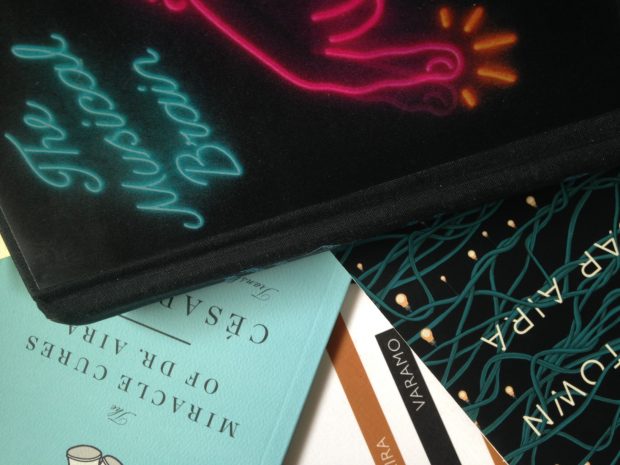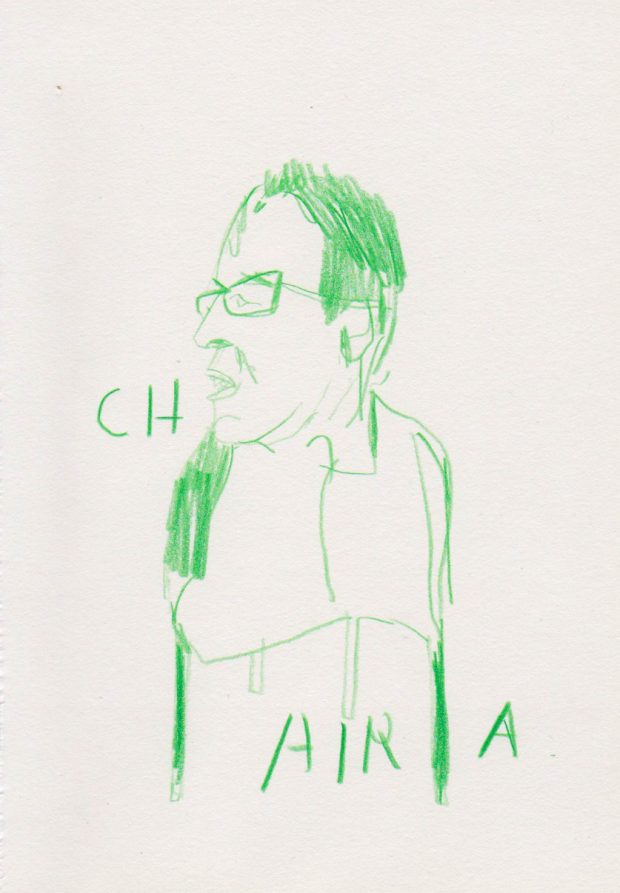Cesar Aira and The Green Ray: What I’ve Been Reading, Part One
by Luke Beesley

I’m currently reading Shantytown by Argentinian author Cesar Aira. It’s the seventh Aira (6 novels and a short story collection) I’ve read since I began reading him in – when was it? – late 2014? He really was the literary discovery of 2014/2015 for me, and as I began reading I simultaneously learned of his eccentric processes or methods, which involve sitting in a café each morning with an espresso, writing one-or-two pages in fountain pen on paper, picking up from the hijinks (the plot) of the day previous, and then spending the rest of the day reading, cycling or watching movies. He supposedly edits his novellas hardly at all, preferring to leave his maneuvering on the page. It’s central to his art, really: the good the bad – all – is there to observe, as he tries to untangle himself from the plot-clot he found himself in the day before. (I was shocked, initially, and fascinated to read more on his technique because, 6 months before I discovered Aira, I began to experiment with a type of one-or-two-page-a-day improvisational prose-writing which was not too dissimilar; I’d try to use a memory of the previous day’s plot, rather than reading over the previous day’s pages, to expand the narrative. This came out of an idea that didn’t work so well of writing half a story, then going to sleep, hoping to use any content from a dream to help to complete it.)
I started reading the few English translations of Aira’s novels with How I Became a Nun. (6 year old boy or perhaps girl baulks at weird inevitably poisonous strawberry ice-cream before more strange plot points drip all over the fingers and hands while reading the story, no doubt melting away from the lovely ice cream on the cover of the book, one of my favourite of all the New Directions Aira covers). I followed How I Became a Nun with An Episode in the Life of a Landscape Painter, often described as Aira’s most conventional or least genre-jumpy novel about a famous painter struck by a lightning bolt that deforms his face (though to write struck is not quite right, he is more penciled by the lightning like a sketch). The Literary Conference came next (hesitation on the way to a literary conference or the problem of the great rope-attached-to-the-horizon riddle, a talisman for the botched cloning of the author Carlos Fuentes which leads inevitably to the book’s climax: giant neon-blue blobby worms attack!), then The Miracle Cures of Dr. Aira (rumours aplenty about a guy called Cesar, a miracle worker who has yet to actually perform one, who inevitably finds himself at the centre of a film set, an elaborate joke), followed by the published-in-English-in-Australia-by-Giramondo Varamo (cars try to race the slowest in the middle of a famous poem by the narrator who must write his way out of debt before his piano-playing embalmed goldfish rots and the police find out he’s carrying counterfeit money!) All of these plots, as wild as they seem, offer a metaphor for their own making, and for the making of writing/art in general.
At some point during the reading of the above novels, Aira’s latest book, The Musical Brain and Other Stories came out. It’s Aira’s collection of short fiction, or fiction-too-short-to-publish-individually in novella form. Each of Aira’s many many works have been published individually in Spanish, by small presses, and often in little pamphlets. The Musical Brain… was given a real leg-up by Patti Smith in The New York Times.
So I’m now reading Shantytown. It’s about a shantytown in Buenos Aires whose strange inhabitants (who may actually just be black smears on a mirror) have figured out how to steal electricity, and so the whole round shantytown is lit by lamps strung all through the streets. They’re tangled in amongst the words SHANTYTOWN on the cover, too, and even through Aira’s own name, threading right through the little triangle of both capital As and back and behind the cleverly chosen “Aira should not be missed.” – The New York Times”. He happens so fast. Is there such thing as meta-publicity? I’m only up to page 63 and it looks at this stage/page, as in any other page/stage in Aira, that the bulbs might represent each character’s misunderstanding of the story of a disappearance, each story knotted beyond the truth. No doubt, at some point, someone in the novel will sip a coffee in a café, or walk by a café, and the reader will imagine Aira, sitting next to his empty espresso cup.
This must have been about the time I started watching all the films of Eric Rohmer or at the beginning of my Aira phase I also discovered British filmmaker Joanna Hogg. Hogg makes – and I didn’t realise it at the time because I hadn’t watched Rohmer yet – Rohmer-like films set around a specific architecture, often a holiday home, but injects a little more emotion and horrible-exquisite social awkwardness into them, as opposed to the typical slightly-distanced intellectual talkiness of Rohmer film. Sort of like the difference between the prose of Hemingway and the prose of William Maxwell. For some reason Hemingway has continued to return to me over the last few years, and in differing contexts – I listened to his Paris memoir, A Moveable Feast, on audio book last year as I was walking early in the morning. There was something grotesque about that book – a guttural sort of posturing and those awkward interactions with F. Scott Fitzgerald – but at the same time I do find myself going to the bookshelf to just pick up a novel of his to test the Hemingway line. I like to just slip into that line, sometimes. Book. Shelf. Get a sense of his nouns. It’s little wonder that I came across Spanish prankster Enrique Vila-Matas’ Never Any End to Paris. With a thirst for funny Aira-type meta-fiction building I searched out other names associated with Aira, and Vila-Matas came up a few times so I went to Baillieu Library, Uni of Melbourne (where I can borrow up to ten books thanks to some kind of inter-library high five), and found a few of his novels. I had them in my hands on a day that the university had removed a good 30 meters of shelving, all the way down one side of to library, up there in the Baillieu, where you can look out from the musty 1960s decor and modernist international fiction into the gorgeous swaying branches of the lush green trees outside in a sort of glorious procrastination.
Aside from everything, I couldn’t decide on which Vila-Matas to read, so I read the first page of each of the novels they had in the library. Dublinesque, Montano and Never Any End to Paris. I enjoyed the opening of Dublinesque but liked Montano even more. Vila-Matas mostly writes with sly first-person (Vila-Matas-like) protagonists who shapeshift around an ambiguous meta-fictional plotline full of irony and little smirks. Never Any End to Paris was a clear winner. It begins with the protagonist entering the Earnest Hemingway lookalike contest held in Key West (Florida) every year. I doesn’t go so well…
… I was disqualified; worst of all they didn’t throw me out of the competition because they discovered the false beard – which they did not – but because of my “absolute lack of physical resemblance to Hemingway.”
A friend – who often has a knack for seeing a person’s child-self or elderly-self, actually she believes that each person has, inherently, a look that makes it easier to imagine their child-face or their elderly-face – said I’d perhaps look a bit like John Cage when/if I’m ever elderly, and I guess I was pretty fine with that. Reports on Cage’s antics regularly found their way into the The New Yorker, and often on the same page as his contemporary, William Maxwell, the fiction editor from 1936 to 1975. Maxwell nurtured the careers of a number of significant American authors and also found the time to write 6 novels and 6 short story collections. My Aira phase coincided with going for walks in the morning and figuring out how to podcast on my iPhone. The first podcasts I searched out were any that may have even just brushed up against Aira’s name. The best podcast I found was, Who Is Cesar Aira? (from Notebooks on Cities and Culture) a conversation with three Aira translators – Katherine Silver, Rosalie Knecht and our own Chris Andrews, whose segment is fascinating, particularly the discussion around Aira and the avant-garde, and how Aira might hope to “one day become a kind of paradigm for a new set of literary values”.
 Sydney-based poet (see Lime Green Chair), academic and translator, Chris Andrews also happens to be the secondary supervisor of my doctorate. He quietly goes about the translation of some of the key Latin American novels of the late 20th and early 21st century. He’s translated most of Aria’s English novels, his short story collection, and of course was the main translator for celebrated Chilean author Roberto Bolano. I started reading Aira, curious about Chris’ work, knowing I’d had trouble getting into Bolano in the past, after finding How I Became a Nun in the Baillieu Library. It has such a lovely cover. At the centre of which is a large scoop of strawberry ice cream.
Sydney-based poet (see Lime Green Chair), academic and translator, Chris Andrews also happens to be the secondary supervisor of my doctorate. He quietly goes about the translation of some of the key Latin American novels of the late 20th and early 21st century. He’s translated most of Aria’s English novels, his short story collection, and of course was the main translator for celebrated Chilean author Roberto Bolano. I started reading Aira, curious about Chris’ work, knowing I’d had trouble getting into Bolano in the past, after finding How I Became a Nun in the Baillieu Library. It has such a lovely cover. At the centre of which is a large scoop of strawberry ice cream.
Just a few months ago, now an expert a trawling the podcast world for intelligent literary (and tennis) comment, I was listening to an interview with Michael Ondaatje who chose William Maxwell’s novella So Long, See You Tomorrow as a book most significant to him. I couldn’t get a hold of that novel, but I found this excellent interview and also The Chateau (1961) a novel loosely based on a holiday Maxwell took. A middle-class American couple visit France just after the 2nd world war. Very Joanna Hogg, they take two awkward weeks in a 17th century chateau just outside of Paris, only to discover a traumatised France groggily, impossibly, returning to post WWII life. It’s full of awkward and perplexing moments in clear, rhythmic empathic prose. Having finished The Chateau, I discovered I had one more Aira book on my shelf left to read… Just this morning I finished the last paragraph at the end of Shantytown’s Chapter 6, page 85, and absolutely had to sneak it into this post:
…People always assume that to improvise is to act without thinking. But if you do something on an impulse, or because you feel like it, or just like that, without knowing why, it’s still you doing it, and you have a history that has led to that particular point in your life, so it’s not really a thoughtless act, far from it; you couldn’t have given it any more thought: you’ve been thinking it out ever since you were born.
Drawings and images © Luke Beesley 2016